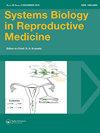小鼠支持细胞中STUB1的表达调控及其生物学意义
IF 2.1
4区 医学
Q3 ANDROLOGY
引用次数: 2
摘要
STIP1同源性和U-Box Containing Protein 1 (STUB1)是一种泛素E3连接酶,最初参与免疫应答,最近被发现是不同生物系统的多效调节因子,包括骨骼和男性生殖系统。关于后者,在性腺功能减退症患者中发现了STUB1基因的纯合突变。然而,迄今为止,STUB1在睾丸中的表达模式和生物学作用仍未被探索。在此,我们报道分析了精子发生受损的人睾丸中STUB1的表达、小鼠睾丸发育中STUB1表达的旁分泌调节以及消融STUB1对支持细胞(SC)功能的直接影响。STUB1在正常人睾丸粗线精母细胞和sc中大量表达,而在精原细胞和分化精母细胞中表达较弱。相比之下,在精子发生受损的人类睾丸中,sertoli特异性表达STUB1显著降低。然而,在小鼠睾丸出生后的整个发育过程中,STUB1仅在功能成熟的sc的细胞核中表达。邻近生殖细胞(GC)来源的IL-1α通过促进ETS结构域转录因子Elk-1 (ELK1)介导的反激活来调节STUB1的表达。重要的是,内源性STUB1的消融导致GC共孵育SCs的脂质积累和衰老。结合之前关于IL-1α对细胞衰老的刺激作用的报道,我们的研究结果表明,STUB1可能作为一个重要的负反馈信号来调节gcs来源的IL-1α的大小,而在睾丸内,IL-1α通常维持在低水平。本文章由计算机程序翻译,如有差异,请以英文原文为准。
Regulation of STUB1 expression and its biological significance in mouse Sertoli cells
Abstract STIP1 Homology and U-Box Containing Protein 1 (STUB1), a ubiquitin E3 ligase initially involved in immune responses, has recently emerged as a pleiotropic regulator of different biological systems, including skeletal and male reproduction systems. On the latter, a homozygous mutation in the STUB1 gene has been identified in patients with hypogonadism. However, the pattern of expression and biological actions of STUB1 in testis remains so far unexplored. Herein, we report analyses on the testicular expression of STUB1 in human testes with impaired spermatogenesis and paracrine regulation of STUB1 expression in mouse testis development and the direct effects of ablation STUB1 on Sertoli cell (SC) functions. STUB1 was expressed abundantly in pachytene spermatocytes and SCs, and weakly in spermatogonia and differentiating spermatids in normal human testis. In contrast, Sertoli-specific expression of STUB1 was significantly decreased in the human testes with impaired spermatogenesis. Throughout postnatal development of mouse testis, however, STUB1 was expressed exclusively in the nuclei of the functionally mature SCs. The adjacent germ cell (GC)-derived IL-1α overtly regulated STUB1 expression through promoting the ETS domain transcription factor Elk-1 (ELK1)-mediated transactivation. Importantly, ablation of endogenous STUB1 caused lipid accumulation and senescence in GC co-incubated SCs. Together with previous reports on the stimulatory effects of IL-1α on cell senescence, our findings suggest that STUB1 may serve as an important negative feedback signaling to modulate the magnitude of GCs-derived IL-1α, which is normally maintained at low levels within testis.
求助全文
通过发布文献求助,成功后即可免费获取论文全文。
去求助
来源期刊
CiteScore
4.30
自引率
4.20%
发文量
27
审稿时长
>12 weeks
期刊介绍:
Systems Biology in Reproductive Medicine, SBiRM, publishes Research Articles, Communications, Applications Notes that include protocols a Clinical Corner that includes case reports, Review Articles and Hypotheses and Letters to the Editor on human and animal reproduction. The journal will highlight the use of systems approaches including genomic, cellular, proteomic, metabolomic, bioinformatic, molecular, and biochemical, to address fundamental questions in reproductive biology, reproductive medicine, and translational research. The journal publishes research involving human and animal gametes, stem cells, developmental biology and toxicology, and clinical care in reproductive medicine. Specific areas of interest to the journal include: male factor infertility and germ cell biology, reproductive technologies (gamete micro-manipulation and cryopreservation, in vitro fertilization/embryo transfer (IVF/ET) and contraception. Research that is directed towards developing new or enhanced technologies for clinical medicine or scientific research in reproduction is of significant interest to the journal.

 求助内容:
求助内容: 应助结果提醒方式:
应助结果提醒方式:


